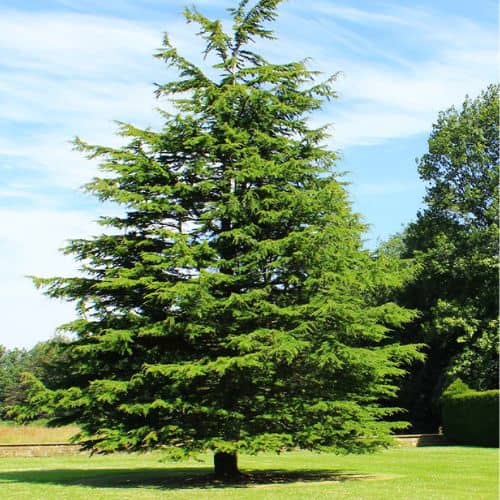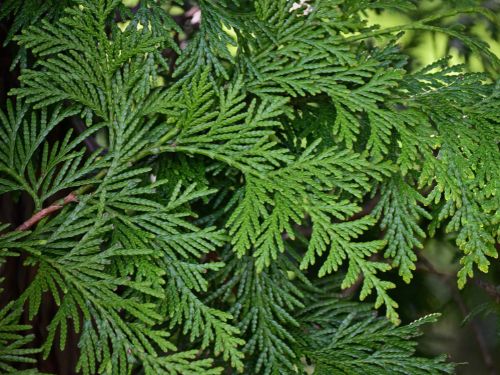Cedar trees, belonging to the genus Cedrus, encompasses several species, including the Atlas cedar (Cedrus atlantica), Deodar cedar (Cedrus deodara), and Lebanon cedar (Cedrus libani), each possessing unique characteristics. These trees are renowned for their slow to moderate growth, these conifers mature into towering specimens that punctuate the skyline with their distinctive silhouettes.

Growing and Caring for Cedar Trees
Cedar trees are well-suited to regions with well-drained soil and ample sunlight. Proper care from the early stages ensures the development of a robust and resilient cedar tree. Planting young saplings in a location with full sun exposure and soil that drains well is crucial. Adequate watering during the establishment phase is essential, and a layer of organic mulch around the base helps retain moisture and suppress weeds.
Cedar trees are known for their low maintenance requirements once established. Regular watering during dry spells is beneficial, and a balanced fertilizer application in spring promotes healthy growth. Pruning is minimal; only focus on removing dead or damaged branches to maintain the tree’s structural integrity. Mulching around the base helps regulate soil temperature and retains moisture, contributing to the overall well-being of the cedar.
Size and Shape
Cedar trees are renowned for their stately and imposing presence. Depending on the species, they can reach impressive heights, often exceeding 100 feet. The majestic stature of cedar trees is complemented by a symmetrical and pyramidal shape, creating a striking silhouette in the landscape. The horizontal branches of mature cedars spread wide, creating a sense of grandeur and providing ample shade beneath their canopies.
The growth rate of cedar trees varies among species, but they are generally considered slow to moderate growers. While their deliberate pace may test the patience of some gardeners, the reward lies in the tree’s longevity and robust structure. Slow growth contributes to the dense wood characteristic of cedars, making them desirable for various applications.
Wood, Branches, and Needles
One of the most renowned aspects of cedar trees is their wood and its enchanting aroma. Cedar wood is prized for its durability, resistance to decay, and natural insect-repelling properties. These attributes make cedar wood a preferred choice for various construction and woodworking applications, including furniture, fencing, and outdoor structures. The unmistakable fragrance of cedar wood is often associated with closets and storage chests. The aromatic compounds in cedar wood also act as natural repellents against moths and other pests.
The branches of cedar trees are strong and horizontally spreading, creating a distinctive layered effect. This branching pattern enhances the tree’s visual allure and contributes to its durability, enabling it to withstand adverse weather conditions. While cedar trees are not known for conspicuous flowers, some species produce small, inconspicuous cones that add a subtle charm to the overall appearance.
Cedar trees boast evergreen needles that adorn their branches throughout the year. The needles are typically arranged in clusters, and their color varies among species, ranging from vibrant green to bluish-green hues. These needles are a defining feature that contributes to the tree’s aesthetic appeal and provides year-round visual interest.

Uses in the Garden
Their large size makes these trees ideal for creating focal points or providing shade in expansive gardens. When planted along property borders, cedar trees act as effective windbreaks and privacy screens, enhancing the overall functionality of outdoor spaces. The dense foliage of cedar trees also contributes to soil conservation by reducing erosion and providing a habitat for beneficial wildlife. Birds often find refuge in the branches, adding an auditory and visual element to the garden. Additionally, the aromatic wood and needles of cedar trees create a sensory experience, infusing the air with a refreshing scent that adds to the overall ambiance of the garden.
Frequently Asked Questions
Do Cedar Trees Attract Ticks?
Cedar trees don’t attract ticks, but they can provide an environment that ticks like. Ticks are often found in wooded areas with dense vegetation, including areas with cedar trees. Cedar trees can provide shade and moisture, which ticks prefer. Additionally, cedar trees often have a layer of leaf litter or debris underneath them, which creates a suitable habitat for ticks and their hosts, such as mice and deer.
Do Deer Like Cedar Trees?
Deer do not typically browse on cedar trees as a preferred food source due to their bitter taste. However, deer may occasionally nibble on cedar branches if other food sources are scarce, particularly during harsh winter months when other vegetation is less available. However, deer might rub their antlers against cedar trees during the rutting season to mark territory and remove velvet from their antlers.
When To Plant Cedar Trees?
The best time to plant cedar trees depends on the specific species of cedar and your local climate. In general, early spring or late fall are good times for planting most types of cedar trees. This timing allows the trees to establish their root systems before the stress of hot summer or cold winter conditions. Avoid planting during periods of extreme heat or drought, as young cedar trees are more susceptible to stress during these conditions. Similarly, avoid planting during periods of heavy rain or flooding, as excessively wet soil can lead to root rot.
